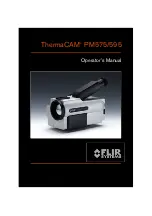
However, the most common result of the identification and classification of the detected
faults is a recommendation to repair immediately or as soon as it is practically possible.
It is important that the repair crew is aware of the physical principles for the identifica-
tion of defects. If a defect shows a high temperature and is in a critical situation, it is
very common that the repair personnel expect to find a highly corroded component.
It should also come as no surprise to the repair crew that a connection, which is
usually healthy, can give the same high temperatures as a corroded one if it has come
loose. These misinterpretations are quite common and risk putting in doubt the relia-
bility of the infrared survey.
7.2.7
Control
A repaired component should be controlled as soon as possible after the repair. It is
not efficient to wait for the next scheduled IR survey in order to combine a new inspec-
tion with the control of the repaired defects. The statistics on the effect of the repair
show that up to a third of the repaired defects still show overheating. That is the same
as saying that those defects present a potential risk of failure.
To wait until the next scheduled IR survey represents an unnecessary risk for the
plant.
Besides increasing the efficiency of the maintenance cycle (measured in terms of
lower risk for the plant) the immediate control of the repair work brings other advan-
tages to the performance of the repair crew itself.
When a defect still shows overheating after the repair, the determination of the cause
of overheating improves the repair procedure, helps choose the best component
suppliers and detect design shortcomings on the electrical installation. The crew
rapidly sees the effect of the work and can learn quickly both from successful repairs
and from mistakes.
Another reason to provide the repair crew with an IR instrument is that many of the
defects detected during the IR survey are of low gravity. Instead of repairing them,
which consumes maintenance and production time, it can be decided to keep these
defects under control. Therefore the maintenance personnel should have access to
their own IR equipment.
It is common to note on the report form the type of fault observed during the repair
as well as the action taken. These observations make an important source of experi-
ence that can be used to reduce stock, choose the best suppliers or to train new
maintenance personnel.
7
Publ. No. 1558240 Rev. a156 – ENGLISH (EN) – March 1, 2006
25
7 – Introduction to thermographic inspections of electrical installations






































